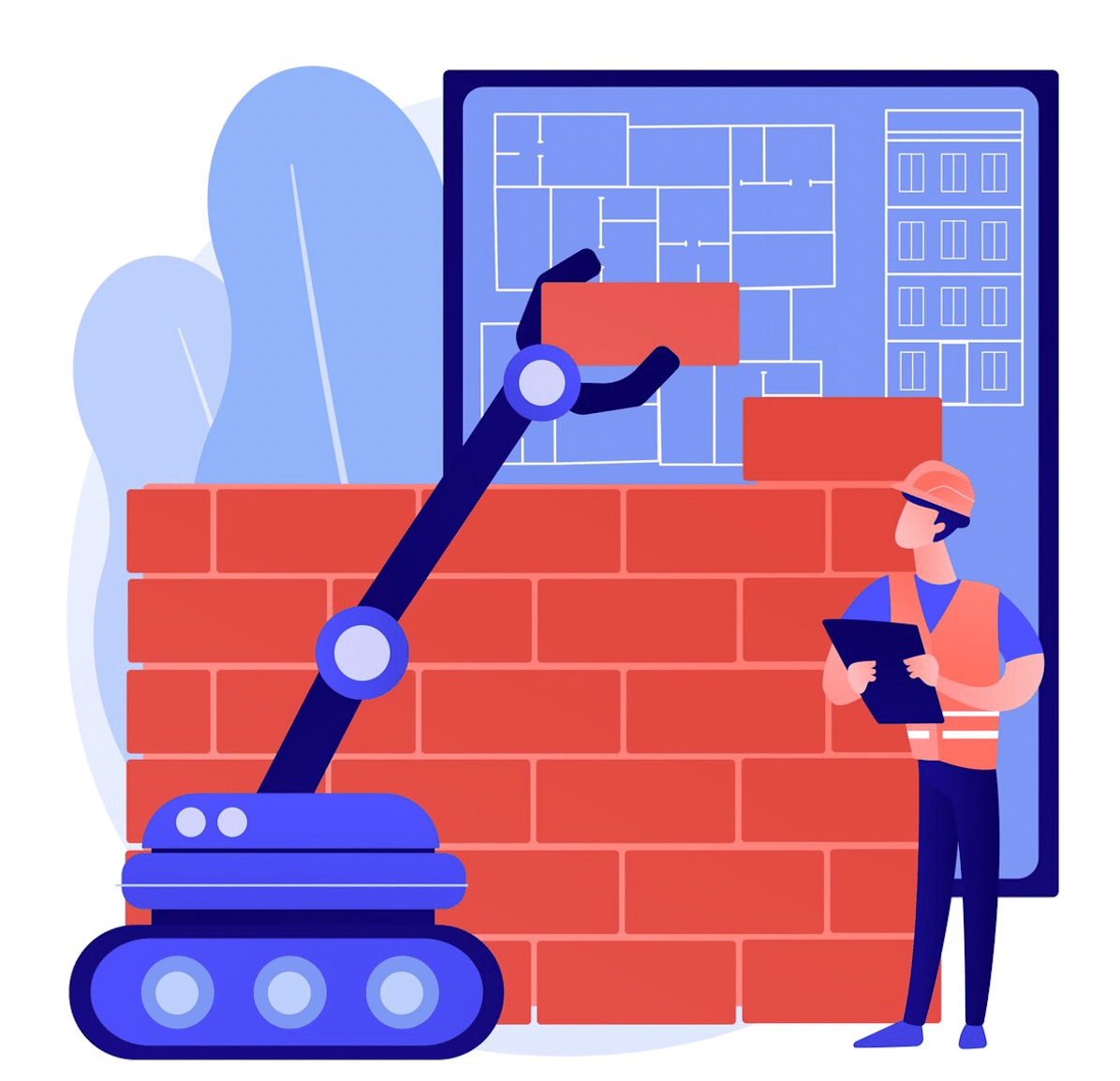
Introduction: How Construction Robots Will Shake up the Industry.
The use of construction robots has taken the construction industry by storm in recent years. There will be major changes coming to the industry as a result of the impact of technology on the market. Let us learn more in this blogpost.
Table of contents
Why Construction Robots?
The integration of robotics brings a multitude of benefits to the construction industry. Robots can undertake repetitive, physically demanding, or dangerous tasks, enhancing worker safety and reducing workplace accidents. Tasks such as tearing down walls or floors or laying bricks, which can expose humans to hazardous materials and conditions or result in high levels of fatigue and injury, can be safely assigned to demolition and bricklaying robots.
The adoption of construction robots also boosts productivity and efficiency. These machines can operate continuously without fatigue, significantly speeding up the progress of construction projects. The precision of robots minimizes human errors that could potentially lead to costly delays and material wastage. For example, robotic total stations used for layout ensure pinpoint accuracy when positioning and marking points on a construction site.
The construction industry faces the ongoing challenge of a labor shortage, with a decreasing availability of skilled workers in many regions. Robots can fill this labor gap by carrying out tasks such as bricklaying, rebar tying, surveying, and inspection. Thus, the implementation of robotics in construction serves as a practical solution to real-world industry challenges, ensuring that projects continue to progress smoothly despite labor shortages.
A historical perspective shows that the construction industry has been historically one of the least automated and technologically advanced industries in the world. A wide range of construction technology companies across the globe are working hard to change this trend.
It appears that there are a great number of examples of firms introducing effective technology into the industry right now. In recent years, multiple businesses have worked to develop driverless technology for road paving and rollers, in addition to innovative communication tools such as LaborChart, which has been developed to speed up communication between suppliers and contractors.
It has been interesting to see how a range of companies in the construction technology space have been experimenting with robotics solutions, such as Built Robotics’ Material Unit Lift Enhancer (MULE), which is capable of handling and placing a wide array of construction materials on construction sites without human intervention. There have also been efforts on-site in other areas such as the introduction of SAM, short for Semi-Automated Mason, which is a bricklaying robot that can be programmed to lay bricks automatically.
It is almost certain that robots will revolutionize construction, since it is a highly un-automated but standardized industry.
Also Read: This Robot-Built House Could Change Everything.
What Are Construction Robots?
The use of construction robots is the automation of machines that assist in constructing buildings. The fear that robots will take away jobs is understandable, as most jobs that humans do now can be fully automated by robots in a regulated manner in construction.
Types of Construction Robots
There have been a number of different robots that have made their way into the construction industry over the past few years. World’s first 3D-printed bridge was actually constructed by a robot that was equipped with 3D-printing capabilities. A mobile robot arm is used to control a 3D printer and perform movements according to pre-programmed instructions.
FBR, a construction technology company based in Australia, has developed a bricklaying robot. There have also been instances where robots have been used to construct a whole street at a time, which has improved the efficiency of construction projects in quality, speed, and general efficiency.
Recent developments in demolition robots have also been on the scene, which are about to break into the mainstream application across many construction sites. Although they may not be as fast as human demolition crews when performing demolition operations, they are significantly safer, more efficient, and cost-effective than human demolition crews when performing demolition operations.
The construction robot market is not restricted to the above processes, as there are so many other types of construction robots. Moreover, new innovative construction technology companies are developing new solutions all around the world. There have been some recent developments in the field that include the use of remote controlled and autonomous vehicles.
In a field that remains relatively un-automated, such as the construction industry, these new technologies surrounding robotics will have a major impact on the construction industry. There is an increasing demand for robotics as companies automate operations. This means that robotics will continue to grow in demand as they reduce costs whilst increasing productivity.
Industrial Robots
The industrial robots, which are used in the manufacturing industry, are some of the most well-known examples of automation. Due to the continued advancement of construction technology, the construction industry has seen a rise in the use of robotics in order to perform repetitive, high-value tasks.
What are Articulated Robots?
An articulated robot is a piece of robotics that is used in the manufacturing process. The robotic arm is similar to a human arm, and they can be used for a wide range of tasks and applications. The uses for articulated robots range from simple assembly processes to heavy duty welding operations.
The versatility of articulated robots has in fact made them so useful that they are still being used in space construction. For example, the Canadarms are robotic crane attachments attached to the International Space Station and the Lunar Gateway, which mean there is a reduced need for human involvement.
3D Printing Using Cartesian Robots
The cartesian robot, also referred to as the linear robot or gantry robot, is a robot that uses the three-axis system (X, Y and Z) of cartesian coordinates to maneuver around. One of the most popular uses of these robots is for picking up and carrying packages and loading them, but there is one task that has blown up in popularity recently: 3D printing.
The 3D printing application in the construction industry has one of the highest level of popularity of any application. One of the reasons for this is the ability to make a variety of 3-D printed products, including a home. It may very well be that 3D printing a home is the future of traditional home building for its quick, efficient, and affordable nature.
Humans Working Together With Collaborative Robots
A collaborative robot – or what is known as a Cobot, for short – is a robot that works alongside humans or other machines in order to accomplish tasks that would be impossible for those machines or humans to perform alone. In the construction industry, a consistent labor shortage is an unfortunate trend, but cobots may be able to ease this burden and eventually eliminate the need for human labor for low-skilled jobs.
Throughout the past few years, drones have become increasingly popular in the construction industry, and it comes as no surprise. Drones help increase the safety of construction sites and ensure progress is made throughout a construction project due to their versatility.
Due to their ability to be remotely controlled and equipped with aerial capabilities, these machines are exceptionally suited for providing real-time updates on a construction project. In this way, they revolutionize the way projects are carried out without requiring the involvement of human labor workers.
The use of drones in the construction industry will only grow in the future as the industry continues to grow and innovation increases.
3-D Mapping with Drones
Among many methods we use drones for, is the use of drone mapping, which involves the use of a drone to create a detailed aerial map that can be made into a 3-dimensional model of the worksite. The contractors will then be able to point out and plan for any problems that may occur during the planning process. As a result of the above, a more accurate estimate about the budget can be given, thus saving money in the long run.
Remotely Monitoring and Inspecting Worksites
Drones can provide crucial inspections without the hassle or hassle of renting out large cranes or boom lifts, which require more than one person to operate. The drone’s aerial capability allows it to inspect structures that are difficult to reach from the ground.
Maintaining Security
On a construction project, the most important aspect is security, with thefts costing the industry anywhere between $300 million and $1 billion a year, with fewer than 25 percent of the losses being recovered. There are only so many things humans can accomplish, but with drones, we can easily improve security and make it more efficient. With a single drone operator, the drones can be flown high into the air and taken in aerial views of the surrounding area and immediately improve security or document evidence.
Self-Driving Construction Vehicles
While the automobile industry is currently working on standardizing self-driving cars, such as Tesla’s Autopilot feature, the construction industry has already been utilizing autonomous construction equipment for some time now.
The company Built Robotics specializes in the advancement of off-the-shelf heavy equipment by integrating artificial intelligence guidance systems. The company presently offers dozers, excavators, and CTL’s that are completely autonomous in their operation. This is one of the major issues that can be addressed through the use of automated equipment.
Construction workers who are working on a street with traffic can be at risk, and even the best road construction safety plan won’t always prepare them for the possibility of human error. However, autonomous construction vehicles can greatly reduce the possibility of human error.
Upgrading Construction Jobs with the Autonomous Track loader
Build Robotics’ autonomous track loader (ATL) is a compact track loader which is equipped with a LiDAR, or light detection and ranging sensors and augmented GPS, which allows it to work without the need of an operator. An autonomous vehicle like this one is designed for certain light construction tasks, such as excavating for a house.
Dozers
There are several types of dozers, and they can be used to do anything from pushing heavy loads to leveling a variety of soil types. An autonomous dozer from Built Robotics is capable of all that, without a human being being behind the wheel.
Maintaining Work Performance Using Excavators
The Built Robotics’ autonomous excavator is as capable as any other excavator when it comes to foundation excavation, trenching, and truck loading jobs. It performs very well even when an operator is on standby. In addition to the autonomous aspect of the excavator, the less experienced operator is empowered to do much more with the machine. As part of its partnership with Built Robotics, the International Union of Operating Engineers (IUOE) is training its members on how to operate these new self-driving vehicles.
Other factors contributing to their popularity are safety and convenience. In spite of the fact that heavy equipment operators undergo extensive training, accidents involving both operators and equipment still occur on a daily basis. With the advent of autonomous construction equipment, human error is virtually eliminated.
Humanoid Laborers
At the moment, the construction industry is suffering from a severe labor shortage. Even though there are still a number of positions to fill in the industry, it seems that there is a lack of skills among the applicants. In this context, an autonomous humanoid laborer comes into play: a robot with features that are human-like, yet completely autonomous.
The following robots are not to be confused with other androids, like Chief Operations Officer Data from Star Trek, but they are a much closer representation of that reality.
HRP-5P Humanoid
The HRP-5P is probably the closest humanoid robot to perform feats similar to those performed by humans. The HRP-5P is a humanoid robot developed by Japan’s Advanced Industrial Science and Technology Corporation, which uses a combination of environment detection and object recognition technology to perform a variety of tasks.
In spite of the fact that the HRP-5P is still in the prototype phase, it can already operate power tools and install drywall sheets without the assistance of a human. Even though the HRP-5P is still around, there is still a need for laborers, so it cannot be completely ignored.
Colonizing Space with Robots and Humanoids
The process of building in space involves both developing and building out into space, and although this aspect of space construction is already becoming a reality, there are still some difficult steps to accomplish, such as building and setting up on Mars, which is where NASA’s R5 will come in. It is also called the Valkyrie, and it is designed to be one ” robust, rugged, entirely electric, humanoid robot capable of operating in degraded or damaged human-engineered environments “.
Like her namesake, the Valkyrie’s main purpose is to serve as a guide to the human race to a land that promises success and prosperity. We are still in the midst of pre-development of the Mars Colony and sending a few of these humanoid laborers to do the job may be just what we need to become a multi-planetary species.
Also Read: Artificial Intelligence the self-designing machine
How Are Robots Changing the Construction Industry?
Technological advancements are all about improving the human experience. The role of construction robots is to assist and adapt to the ever-changing world in which we live today.
In the context of construction, safety is important for all aspects of any project on any construction site, and technology enhancements are primarily used to promote safety in construction.
Although robots can replace humans for different work, such as underwater building, the construction industry is one of the most dangerous in the world, so they are doing so as a way of improving safety and helping with work.
There is no doubt that workers will soon be replaced by robots in the workplace. There is still a need for a human touch for many of these different robotics, such as drones or cobots. There is no doubt that robots are here to stay, and do most jobs that humans can do. Robots will make construction safer and allow efficiencies where construction firms, construction companies struggle. Robot revolution is coming and it is going to revolutionize construction sector in a way we cannot imagine, the long run impact will be cheaper but high quality projects with good customer experience.
References
Bock, Thomas, and Thomas Linner. Construction Robots: Elementary Technologies and Single-Task Construction Robots. Cambridge University Press, 2016.
Chamberlain, Alan. Automation and Robotics in Construction XI. Newnes, 2012.
Cousineau, Leslie, and Nobuyasu Miura. Construction Robots: The Search for New Building Technology in Japan. ASCE Publications, 1998.











